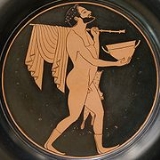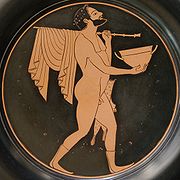
Epiktetos
Encyclopedia

Attica
Attica is a historical region of Greece, containing Athens, the current capital of Greece. The historical region is centered on the Attic peninsula, which projects into the Aegean Sea...
vase painter in the early red-figure style. Besides Oltos
Oltos
Oltos was a Late Archaic Greek vase painter, active in Athens. From the time between 525 BC and 500 BC, about 150 works by him are known. Two pieces, a cup in Berlin and a cup in Tarquinia , are signed by him as painter.Oltos is thought to have begun his career in the workshop of the potter...
, he is the most important painter of the Pioneer Group
Pioneer Group
The Pioneer Group were a number of red-figure vase painters working in Kerameikos or the potters' quarter of Athens around the beginning of the 5th century BCE. Characterized by John Boardman as perhaps the first conscious art movement in the western tradition, the group comprised the painters...
. He was active between 520 and 490 BC. His name translates as "newly acquired" which is most probably a reference to his slave status.
At the beginning of his career, Epiktetos painted a chalice krater made by the potter Andokides
Andokides
Andokides was a famous potter of Ancient Greece. The painter of his pots was an anonymous artist, the Andokides painter, who is recognized as the creater of the red-figure style, beginning around 530 BC. His work is compared with Exekias, who was said to have created the most detailed and best...
, but later he turned to smaller vessels, such as cups and plates. He worked for a variety of potters, including Andokides, Hischylos and the Nikosthenes-Pamphaios workshop. Since he signed one plate as painter and potter, he must have worked in both functions at least for some time. That plate was avotive offering, dedicated on the Athenian Acropolis. On one kylix
Kylix
Kylix may mean:* Kylix , a genus of snails in the family Drilliidae.*Kylix , a type of drinking cup used in ancient Greece*Kylix , a programming tool...
, he collaborated with the Euergides Painter. He appears to have been aware of his talent, as he signed more than half of the works ascribed to him.
His first vases are bilingual eye-cup
Eye-cup
Eye-cup is the term describing a specific cup type in ancient Greek pottery, distinguished by pairs of eyes painted on the external surface. Classified as kylikes in terms of shape, they were especially widespread in Athens and Chalkis in the second half of the sixth century BC.The bowl of the...
s. Already at this stage, he is technically superior to the early works of Oltos, and omits out-of-date features such as palmette
Palmette
The palmette is a motif in decorative art which, in its most characteristic expression, resembles the fan-shaped leaves of a palm tree. It has an extremely long history, originating in Ancient Egypt with a subsequent development through the art of most of Eurasia, often in forms that bear...
-hearts. He also uses the relief-line technique. Epiktetos is considered a master of the tondo (circular image inside a cup). Often, his vases are only painted on the inside. His miniature drawings are very accurate. His use of colour and ornament is careful and restricted. His lines and details are very balanced, heads and limbs well-proportioned. His use of perspective on figures is very convincing. John Beazley
John Beazley
Sir John Davidson Beazley was an English classical scholar.Born in Glasgow, Scotland, Beazley attended Balliol College, Oxford, where he was a close friend of the poet James Elroy Flecker. After graduating in 1907, Beazley was a student and tutor in Classics at Christ Church, and in 1925 he...
praises Epiktetos: „it is not possible to draw better, only to draw differently “. John Boardman
John Boardman
Jack Melton Boardman, commonly known as John Boardman, is an American former professor of physics at Brooklyn College.- Academic career :...
also lauds him as the „greatest drughtsman in early red-figure vase painting “.
His motifs are interesting, not least from a point of view of modern scholarship. While he rarely depicts mythological
Greek mythology
Greek mythology is the body of myths and legends belonging to the ancient Greeks, concerning their gods and heroes, the nature of the world, and the origins and significance of their own cult and ritual practices. They were a part of religion in ancient Greece...
scenes, which are usually not very original, his everyday scenes are all the more important. He shows Athenian citizens at play, at the symposion and in erotic
Erotica
Erotica are works of art, including literature, photography, film, sculpture and painting, that deal substantively with erotically stimulating or sexually arousing descriptions...
scenes, where he developes new aspects and motifs. He played an important role in the development of the satyr
Satyr
In Greek mythology, satyrs are a troop of male companions of Pan and Dionysus — "satyresses" were a late invention of poets — that roamed the woods and mountains. In myths they are often associated with pipe-playing....
as a figure expression beastlike masculinity. His tondi cease to depict the kneeling runner characteristic of black-figure vase painting; instead his figures squat, kneel or are seated. In some cases, the posture of figures depicted on his vases is nearly identical, while tha action varies greatly. For example, a bent and twisted figure is in once case the Minotaur
Minotaur
In Greek mythology, the Minotaur , as the Greeks imagined him, was a creature with the head of a bull on the body of a man or, as described by Roman poet Ovid, "part man and part bull"...
, in another a man masturbating into a pot, in a third a girl pleasuring herself with a dildo.

Douris
Douris may refer to the following people:*Douris , an Ancient Greek vase painter .*Douris , an Ancient Greek philosopher, writer and tyrant of Samos ....
– another on a vase by Pistoxenos. Epiktetos's work must have received considerable appreciation at the time, as indicated by a pelike
Pelike
A pelike is a one-piece ceramic container similar to an amphora.It has two open handles that are vertical on their lateral aspects and even at the side with the edge of the belly, a narrow neck, a flanged mouth, and a sagging, almost spherical belly....
by the Kleophrades Painter
Kleophrades Painter
The Kleophrades Painter is the name given to the anonymous red-figure Athenian vase painter, who was active from approximately 510 – 470 BCE and whose work, considered amongst the finest of the red figure style, is identified by its stylistic traits....
which is twice falsely signed Epiktetos egraphsen (Epiktetos painted it). The signature is a falsification, suggesting that the vessel was considered more marketable if considered to be by Epiktetos.
External sources
- The Getty Museum - Biography of Epiktetos
- Dimitris Paleothodoros, Epictetos, Peeters, coll. d'Études classiques, Vol. 18, Louvain, 2004.

